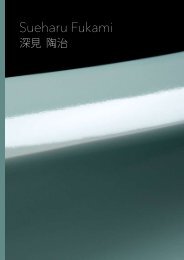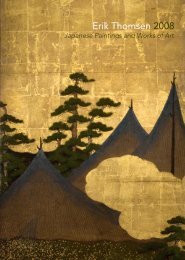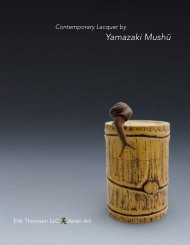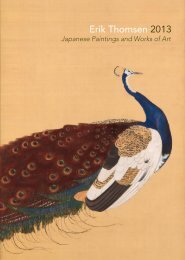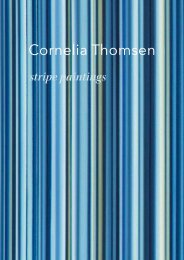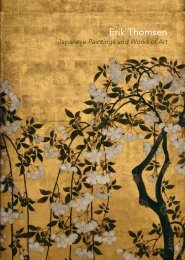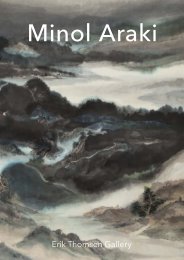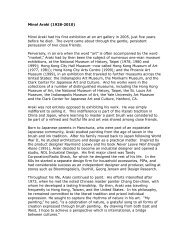View publication (pdf file 6.5 mb) - Erik Thomsen
View publication (pdf file 6.5 mb) - Erik Thomsen
View publication (pdf file 6.5 mb) - Erik Thomsen
- No tags were found...
Create successful ePaper yourself
Turn your PDF publications into a flip-book with our unique Google optimized e-Paper software.
館 所 蔵 ・ 禅 書 画 目 録 . Tokyo: Waseda University AizuYaichi Memorial Museum 早 稲 田 大 学 會 津 八 一 記 念博 物 館 , 2007, page 88; Yamanouchi, Chōzō 山 内 長三 . Hakuin-san no eseppō 白 隠 さんの 絵 説 法 . Tokyo:Daihō Rinkaku 大 法 輪 閣 , 1991, p. 100; MochizukiNoboru 望 月 昇 , ed. Hakuin: Zen to shoga 白 隠 ・ 禅 と書 画 . Kyoto: ADK, 2004, p. 148; Morita, Shiryū 森 田子 龍 , ed. Bokubi Tokushū: Hakuin bokuseki 墨 美 特集 ― 白 隠 墨 蹟 .Collected edition of the issues of theBokubi journal nu<strong>mb</strong>ers 77, 78, 79, and 90, illustratingthe collected works of Hakuin. Kyoto: Bokubisha墨 美 社 , 1985, pp. 86 and 124; Tanahashi, Kazuaki.Penetrating Laughter: Hakuin’s Zen & Art. Woodstock,NY: The Overlook Press, 1984., pl. 30; and Takeuchi,Naoji 竹 内 尚 次 . Hakuin 白 隠 . Tokyo: Chikuma Shoten筑 摩 書 店 , 1964, pl. 375 – 6.3 Hakuin appears to have enjoyed using mojie andthere are numerous other examples of his usingthe technique with other topics and compositions.The tradition is old in Japan with examples datingback to the Heian period. For more on the traditionand on Hakuin’s mojie paintings, see Audrey Seo.Painting-Calligraphy Interactions in the Zen Art ofHakuin Ekaku (1685 –1768). PhD dissertation.University of Kansas, 1997. For more on Hakuin’sMichizane paintings, see pages 253 – 5. See alsoYoshizawa Katsuhiro 芳 澤 勝 弘 . Hakuin no mojie:Hitomaro-zō to Totō Tenjin-zō 白 隠 の 文 字 絵 ― 人 丸 像と 渡 唐 天 神 像 ―. Zen Bunka 禅 文 化 188 (2003)4 The text is the Kanshin nissō jueki 菅 神 入 宋 授 衣 記 .It can be found in the nineteenth volume of Gunshoruiju 群 書 類 従 . A nu<strong>mb</strong>er of other 13th centurytexts deal with this narrative, but the above textseems to be the original one. See article by Yoshizawafor a more complete discussion.Nr. 12 The Hakata Top Crossing a String1 Box, outer inscription on end: »Painting of theHakata Top by Sengai« Hakata koma no e Sengai博 多 コマノ 絵 仙 厓2 For an English-language biography of Sengai,see Stephen Addiss. The Art of Zen: Paintings andCalligraphy by Japanese Monks 1600 –1925. NewYork: Harry N. Abrams, 1989, pp. 176 – 85.3 See for example the humorous street performersin Furuta Shōkin 古 田 紹 欽 . Sengai 仙 厓 . Tokyo:Idemitsu Bijutsukan 出 光 美 術 館 , 1985, pp. 102 – 3;see also Daisetz Suzuki. Sengai: The Zen Master.London: Faber and Faber, 1971, p. 124.4 We see Sengai playing with a similar blurringbetween elite and common factors in the veryexecution of the painting. Here the silk surface hasbeen left only partly sized, which led to the strikingpattern of ink clots on the surface. Moreover, Sengaiseems to have painted on the top of a tatami paneldivision, which left a line intersecting across thetop of the rice bales. This visual clumsiness was notaccidental, as Sengai was thoroughly able to composecareful and skillful images, including works ona large scale and full-sized six-panel screens. Seethe remarkable screens in Takeo Izumi 泉 武 夫 andMinakami Tsutomu 水 上 勉 . Sengai, Hakuin 白 隱 ・仙 厓 . Tokyo: Kōdansha 講 談 社 , 1995, pp. 10 –11,54 – 9. Sengai’s paintings appear unskillful but thiswas clearly an intended effect by the artist. Sengaiwas in fact highly skilled and a great deal of experienceand technical abilities stand behind his works.See for example the interesting article by NishimuraNangaku 西 村 南 岳 . »Sengai Zenga: Honmono,nisemono 仙 厓 禅 画 ・ほんもの、にせもの.« Bokubi墨 美 114 (1962), pp. 5 – 8.5 Daisetz T. Suzuki. Sengai (1750 –1837). Trans. Evavon Hoboken. Vienna: Oesterreichisches Museumfür Angewandte Kunst, 1964, plate 5.6 The catalogue that accompanied the tour featuredthe writing of the famous Buddhism scholarDaisetz T. Suzuki (1870 –1966). Suzuki was animportant author of books and essays on Zenand Pure Land Buddhism that spread interest inBuddhism and Eastern Spiritualism to Westernaudiences, particularly in the 1950s and 1960s.Recent scholars have been somewhat more criticalof his role, see, for example, Robert Sharf, »Who’sZen: Zen Nationalism Revisited«, in Rude Awakenings:Zen, the Kyoto School & Zen Nationalism,J. W. Heisig & John Maraldo eds., Nanzen Institutefor Religion and Culture. Honolulu: University ofHawaii Press, 1995.7 Two other examples can be seen in Nichibōshuppansha 日 貿 出 版 社 , ed. Sengai no zenga:Satori no bi 仙 厓 の 禪 画 : 悟 りの 美 . Tokyo: Nichibōshuppansha 日 貿 出 版 社 , 1984, plates 84 and 118.8 Hisamatsu Shin’ichi 久 松 真 一 describes the collectingactivities of the monk in his article: »Sengaino zenfū 仙 厓 の 禪 風 .« Bokubi 墨 美 110 (1961),pp. 11–16.Nr. 13 Fire in Edo1 As for the nu<strong>mb</strong>er of fires for the major cities duringthe 267 years of the Edo period, Osaka had 6major fires, Kyoto had 9, Kanazawa had 3, and Edohad 49 major fires. Kuroki Takashi 黒 木 喬 . Edo no kaji江 戸 の 火 事 . Dōseisha 同 成 社 , 1999, p. 3.2 The painting may very well be the depiction ofthe great Aoyama Fire 青 山 火 事 of the 24th day ofthe first month of 1845, which eventually spreadacross the western part of the city, leading to thedestruction of vast tracts of land, including 187Buddhist temples, and the death of 800 – 900 people.Hata Ichijirō 畑 市 次 郎 . Tōkyō saigai-shi 東 京 災 害 史 .Tokyo: Tosei tsūshin sha 都 政 通 信 社 , 1952, p. 543 A nu<strong>mb</strong>er of fire fighting groups were active inthis area. For an overview, see Kuroki Takashi黒 木 喬 . Edo no kaji 江 戸 の 火 事 . Dōseisha 同 成 社 ,1999.4 For the restaurant culture of Edo, see Hans Bjarne<strong>Thomsen</strong>, »The Other Hiroshige: Connoisseur ofthe Good Life«, Impressions 24 (Dece<strong>mb</strong>er, 2002):pp. 15 – 21 and 48 – 71; and »Food and Art: Hiroshige’sRestaurant prints in the Elvehjem.« Bulletin of theElvehjem Museum of Art, Summer 2002 issue,pp. 27 – 40.5 On the second floor we see a drinking party witha geisha. Interestingly, this information is impartedthrough a shadow on a window—that is, through ashadow of a shadow.6 The name refers to the ratio of buckwheat flour(80%) to wheat flour (20%). This was a type of sobathat was favored in Edo and is harder than the typepreferred today. Due to the fear of fire, the type oftraveling soba seller (with his fire and hot cauldron)that we see on this painting was prohibited in 1799,but the laws were relaxed in the first decades ofthe nineteenth century. By the time this paintingwas made, the prohibition was no longer followed.See: Nagayama Hisao 永 山 久 夫 . Tabemono Edo shiたべもの 江 戸 史 . Tokyo: Shin Jinbutsu Oraisha新 人 物 往 来 社 , 1976.7 See for example, Itō Shiori 伊 藤 紫 織 . »Shini-e togachūga: shōzō toshite no shini-e« 死 絵 と 画 中 画 ・肖 像 としての 死 絵 . Journal of Development and Systematizationof Death and Life Studies, Tokyo University東 京 大 学 グローバルプログラム「 死 生 学 の 展 開 と 組織 化 」(2009) pp. 173 – 96; Osaka Municipal Museumof Art 大 阪 市 立 美 術 館 , ed. Tokubetsuten: Shōzōgasan, hito no sugata hito no kotoba 特 別 展 ・ 肖 像 画賛 = 人 のすがた、 人 のことば. Osaka: Osaka MunicipalMuseum of Art 大 阪 市 立 美 術 館 , 2000, pl. 123; andTimon Screech. The Western Scientific Gaze andPopular Imagery in Later Edo Japan: The Lens withinthe Heart. Ca<strong>mb</strong>ridge, New York and Melbourne:Ca<strong>mb</strong>ridge University Press, 1996, pp. 113 –16.8 This temple, also called the Sasadera 笹 寺 , wasone of the best known temples in the city and aplace for cultural meetings. It was illustrated byHasegawa Settan (1778 –1843) in the Edo meishizue book series, initially published in 1834 with114 115



